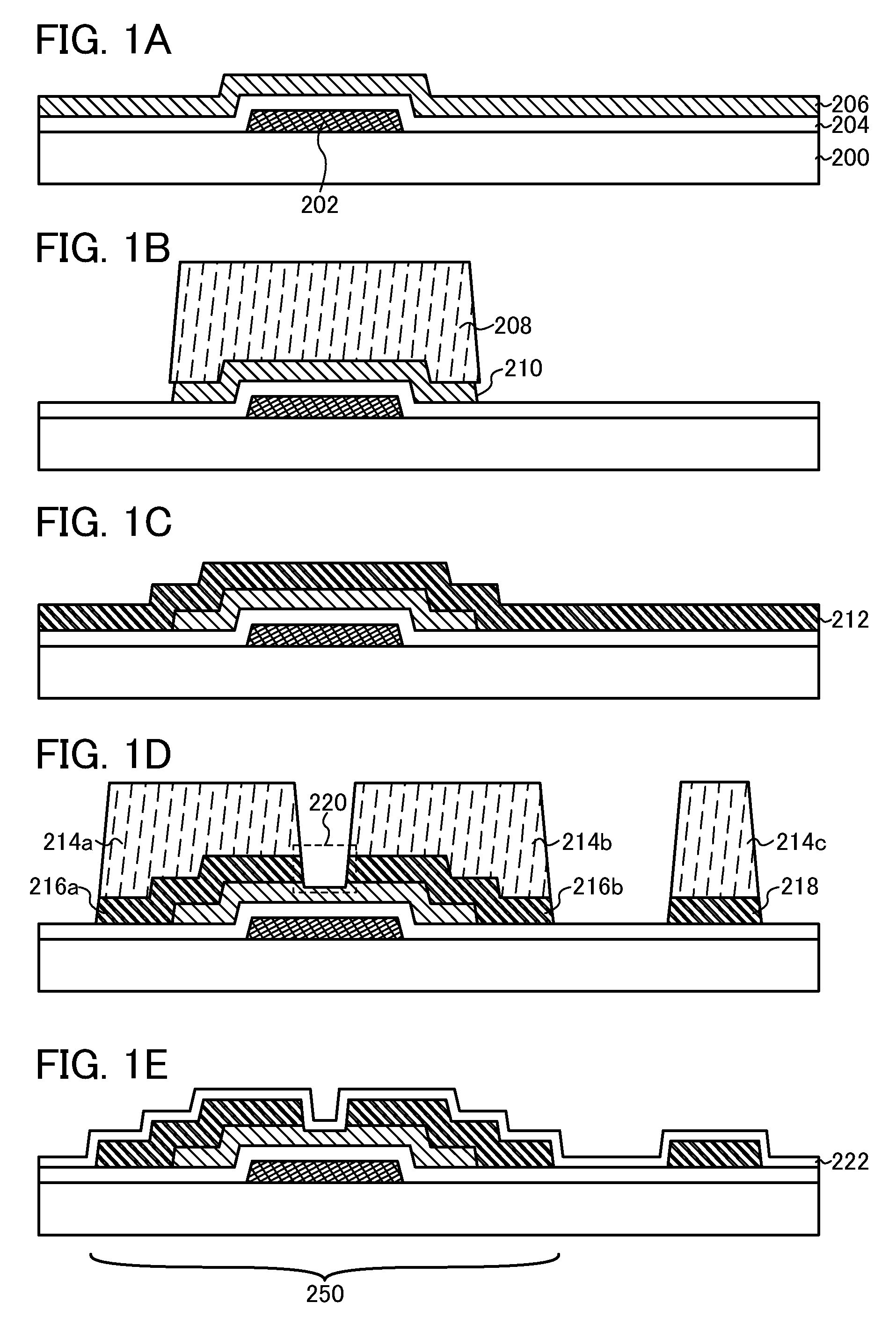Method for manufacturing semiconductor device
a manufacturing method and semiconductor technology, applied in semiconductor devices, digital storage, instruments, etc., can solve the problems of difficult to reduce a cost the processing technique which meets the conditions required for manufacturing a semiconductor device with the use of an oxide semiconductor has not been established, and the major portion of an oxide semiconductor layer including such an expensive metal which is deposited is removed and wasted, so as to improve the performance of the semiconductor device, the effect of improving throughput and miniaturizing the semiconductor devi
- Summary
- Abstract
- Description
- Claims
- Application Information
AI Technical Summary
Benefits of technology
Problems solved by technology
Method used
Image
Examples
embodiment 1
[0059]In this embodiment, an example of a method for manufacturing a semiconductor device is described with reference to FIGS. 1A to 1E.
[0060]First, a gate electrode 202 is formed over a substrate 200 having an insulating surface and then a gate insulating layer 204 and an oxide semiconductor layer 206 are formed over the gate electrode 202 (see FIG. 1A).
[0061]As the substrate 200 having an insulating surface, for example, a glass substrate having a visible light transmitting property, which is used for a liquid crystal display device or the like, can be used. The glass substrate is preferably an alkali-free glass substrate. As an alkali-free glass substrate, for example, a glass material such as aluminosilicate glass, aluminoborosilicate glass, or barium borosilicate glass is used. In addition, as the substrate 200 having an insulating surface, an insulating substrate which is formed of an insulator, such as a ceramic substrate, a quartz substrate, or a sapphire substrate; a semico...
embodiment 2
[0092]In this embodiment, a method for manufacturing a semiconductor device, which is different from that of the above embodiment, is described with reference to drawings. Note that many steps of the method for manufacturing a semiconductor device in this embodiment are common to those of Embodiment 1. Therefore, repeated description of the common steps is omitted and description of steps different from that of Embodiment 1 is made below.
[0093]First, a gate electrode 202 is formed over a substrate 200 having an insulating surface and then a gate insulating layer 204 is formed over the gate electrode 202. After that, an oxide semiconductor layer 206 and an oxide semiconductor layer 207 are stacked thereover (see FIG. 2A).
[0094]The materials and manufacturing method of the gate electrode 202, the gate insulating layer 204, and the oxide semiconductor layer 206 can be referred to Embodiment 1.
[0095]The oxide semiconductor layer 207 can be formed using an In—Ga—Zn—O based non-single-cry...
embodiment 3
[0119]In this embodiment, a method for manufacturing a display device which is an example of a usage mode of a semiconductor device is described with reference to drawings. Note that many steps of the manufacturing method described in this embodiment are common to those of Embodiment 1 or Embodiment 2. Therefore, repeated description of the common steps is omitted and description of steps different from that of Embodiment 1 or Embodiment 2 is made below. Note that in the description below, FIGS. 5A to 5C and FIGS. 6A to 6C are cross-sectional views and FIG. 7, FIG. 8, FIG. 9, and FIG. 10 are top views.
[0120]First, wirings and an electrode (a gate wiring including a gate electrode 202, a capacitor wiring 108, and a first terminal 121) are formed over a substrate 200 having an insulating surface (see FIG. 5A and FIG. 7).
[0121]The capacitor wiring 108 and the first terminal 121 can be formed at the same time and using the same material as the gate electrode 202. Note that the material ...
PUM
 Login to View More
Login to View More Abstract
Description
Claims
Application Information
 Login to View More
Login to View More - R&D
- Intellectual Property
- Life Sciences
- Materials
- Tech Scout
- Unparalleled Data Quality
- Higher Quality Content
- 60% Fewer Hallucinations
Browse by: Latest US Patents, China's latest patents, Technical Efficacy Thesaurus, Application Domain, Technology Topic, Popular Technical Reports.
© 2025 PatSnap. All rights reserved.Legal|Privacy policy|Modern Slavery Act Transparency Statement|Sitemap|About US| Contact US: help@patsnap.com



